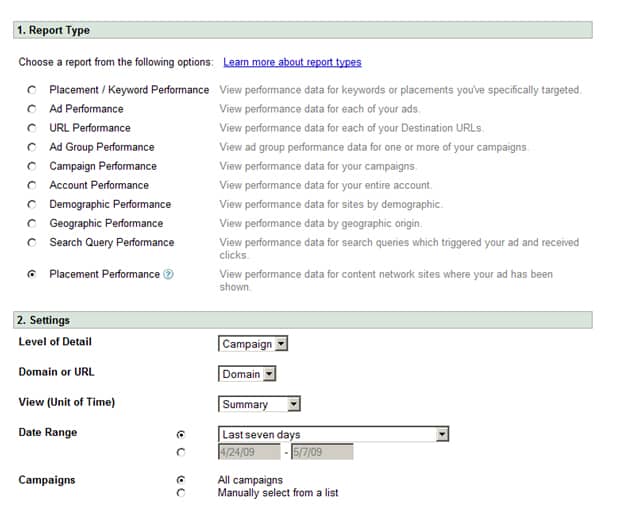The Placement Performance report provides data detailing ad performance on specific domains and URLs in Google’s Content Network. Similar to what a Search Query report does with keywords, the Placement Performance report allows advertisers to weed-out poorly performing sites, so that ads will only appear on the best performing domains and URLs. This is accomplished by adding those poorly performing sites as negative sites to prevent ads from being shown on them.
The placement report is an invaluable resource for AdWords advertisers running content campaigns, but in some cases, advertisers may be using the report incorrectly and inadvertently harming their campaigns.
Trouble can arise depending on what level (campaign or ad group) an advertiser wishes to view site performance data and on what level the advertiser wishes to add negative sites.
An advertiser that plans to add campaign-level negative sites must set the report to display performance data on the campaign level.
If this is not done, an advertiser could be adding negative sites that are actually performing well.
Let me explain.
Ads from within the same campaign, but from different ad groups, can appear on the same content network sites.
For example, an AdWords advertiser is running a content campaign which contains five ads groups. Ads from three of the five ad groups are appearing on madeupwebsite.com.
The advertiser runs an ad group-level Placement Performance report which gives him/her performance data for dozens if not hundreds of sites on which the campaign’s ads are appearing. The advertiser notices that in one ad group, the ads appearing on madeupwebsite.com are performing very poorly and decides to add that site as a campaign-level negative site.
What if, however, the ads from the other two ad group’s are actually performing very well on madeupwebsite.com?
People usually browse the Placement Performance report looking for poorly performing sites, which are usually easier to pick out, so there is probably a decent chance that the good performance data for madeupwebsite.com will be overlooked.
Unless, while looking through the lengthy placement report, the advertiser notices that madeupwebsite.com was performing poorly for one ad group but well for two other ad groups, he/she will end up blocking ads from appearing on a high performing site.
So, the moral of this rather long-winded story is that if you add campaign-level negative sites, you must run a Placement Performance report that displays data on a campaign level. If you are going to add ad group-level negative sites, run the placement report on an ad group level.
Unique ideas for your business
The Demystifier puts practical ideas into your hands. You won't find them elsewhere. Original, actionable and insanely effective.




